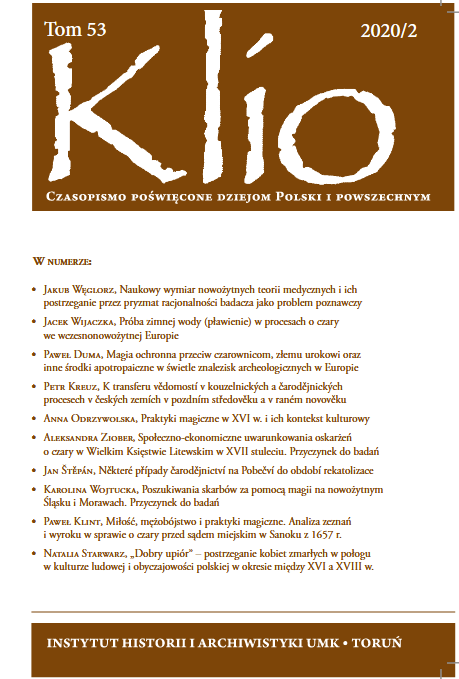„Wampiryczne dzieci” – ofiary wierzeń w magia posthuma na Morawach w XVIII w.
„Vampire Children” – the victims of beliefs
in magia posthuma in Moravia of the 18th century
Author(s): Daniel WojtuckiSubject(s): History, Cultural history, Modern Age
Published by: Wydawnictwo Naukowe Uniwersytetu Mikołaja Kopernika
Keywords: magic; beliefs; vampires; Moravia; 18th century; Austrian Empire
Summary/Abstract: From the end of the 16th century, the areas of the Silesian-Moravian borderland, or northern Moravia itself, were the scene of fierce struggles against the dead rising from their graves. Later, mainly eighteenth-century publications began to use the term defining these phenomena as magia posthuma. The intensity of beliefs in posthumous magic peaked in late 17th and early 18th centuries. It was widely thought at the time that a deceased person whose body does not show normal, postmortem changes (rigidity) was a witch or a sorcerer. In the first half of the 18th century, the belief in harmful dead expanded to include children as well. It was also in this period that people commonly believed that other corpses could be “infected” by a dead person who engaged in sinister posthumous activity. For this reason, also the bodies of children began to be exhumed. It must be emphasized that none of the examined cases of children and toddlers, whose bodies were exhumed and subsequently burned by a hangman, had died before being baptized. One of the first such exhumations in connection with beliefs in magia posthuma practiced by deceased children took place in the spring of 1701 in the village of Libavá (German: Liebau). Yet the mass hysteria and extermination of harmful dead in this village and its vicinities did not break out until 1726. This year, 13 bodies of adults (11 women and 2 men), as well as those of 60 children, were exhumed and burned on the border. The person identified as “patient zero”, who allegedly spread the “witchcraft epidemic”, was Georg Pozler. The number of trials of living and dead, including children, began to decrease after 1755, following a decree issued by the Empress Maria Theresa on 1 March of this year, which was targeted against the old beliefs and superstitions concerning witchcraft, magic, ghosts, apparitions and vampires.
Journal: Klio. Czasopismo poświęcone dziejom Polski i powszechnym
- Issue Year: 53/2020
- Issue No: 2
- Page Range: 211-246
- Page Count: 36
- Language: Polish

